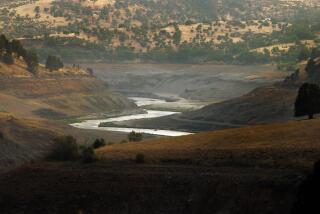Once Obsolete, Folsom Bridge Gets New Life
- Share via
FOLSOM — This is the story of a bridge that left town but came home again.
Back in 1931, the old Folsom Bridge was deemed expendable, its job undercut by a new concrete span erected just down the American River. Sold for $250, the 330-foot steel structure was plucked from its perch and moved half a state away, to the Klamath River near the Oregon border.
The bridge performed ably there for decades, but then history did a rerun: A new span was erected nearby. The spindly steel bridge was declared obsolete once again.
But now, in a feat of gumption and historical zeal, the bridge has returned to Folsom, to its erstwhile home on the American River’s chiseled banks 15 miles east of Sacramento. Girder by girder, crews moved the old bridge and erected it again on its original granite footings.
“It’s fantastic,” said Folsom resident Nick Williams as he eyed the progress of workmen one cloudy day last week. “This has brought back a little bit more of Folsom’s history.”
Used a century ago by stagecoaches, cattle and herds of sheep heading to pasture, the lacy bridge will serve a more modern function as a bike path.
The 106-year-old bridge holds a spot on the National Historic Register and is the oldest and longest of its type, an antique design known as the Pennsylvania Petit truss.
Newly renamed the Folsom Historic Truss Bridge, it is now one of three spans within a half-mile stretch in this railroad stop turned suburban bedroom community. A few hundred feet away is the Rainbow Bridge, an arching concrete structure built in 1917. Farther downriver is a $47-million, four-lane span opened last summer.
Though it is not uncommon for old steel bridges to be moved, it is rare for one to return to its original site, said Michael Chlarson of the Sacramento-based engineering firm CH2MHill, which is overseeing the project for the city.
Folsom’s $1.9-million effort to get the bridge back--roughly double what it would have cost to build a new footbridge from scratch--was in itself something of a construction marvel.
The bridge was dismantled a year ago in Siskiyou County, then shipped south to a plant outside Stockton where the lead coating was stripped and new paint applied. Though about 60% of the original structure is being reused, a number of components--pins and bolts, nuts and beams--had to be replaced because of old age or to meet current building codes.
Earlier this year, crews beefed up the old granite block abutments, the foundation for the span. Work on the bridge itself began in October.
Normally, a bridge is built atop a temporary structure, which supports the span from below. When the Folsom Bridge was first erected in 1893, just such a temporary frame--known as a falsework--was used.
But in the years since then, the river has been heavily mined of gravel and granite, stripping away the base needed to support a temporary work platform in the middle of the gorge.
Rigging International, which is rebuilding the bridge, got around that by erecting falsework from each river bank, leaving a gap in the middle. The entire bridge was built on the southern bank, then slid section by section out over the river on hard plastic runners atop the falsework.
The final move began Nov. 30. Workers erected a 140-foot-tall tower, which straddled the middle of the bridge. Cable from the tower was extended to each end of the span. With a system of pulleys, the entire 130-ton bridge was lifted a few feet off the ground.
Then, as spectators lined the shore, the tower itself was pushed out onto the falsework, a few inches each minute, until the bridge reached the river’s north bank.
“I liken it to pushing a stool with an elephant on it,” Chlarson said. “It was a delicate balancing act.”
Now in place, the bridge is being secured to the stone abutments. New wooden decking will create the 12-foot-wide roadbed and railings will be installed. A grand opening is expected in January.
Chlarson said the project has made him appreciate the efforts of the crews that first built the bridge.
“We come to think we’re so highly advanced today,” Chlarson said. “But a century ago they put this bridge up with steam engines and horse teams and block and tackle. They were doing some very, very remarkable things.”
More to Read
Sign up for Essential California
The most important California stories and recommendations in your inbox every morning.
You may occasionally receive promotional content from the Los Angeles Times.













